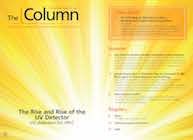Novel Flow-Confinement Concept for LC×LC
A novel flow-confinement concept designed to remove the performance sacrifice associated with current comprehensive two-dimensional liquid chromatography techniques has been tested by researchers.
Photo Credit:deomis/stock.adobe.com

A novel flow-confinement concept designed to remove the performance sacrifice associated with current comprehensive two-dimensional liquid chromatography techniques has been tested by researchers (1).
The characterization of highly complex samples is always a challenge, often requiring a comprehensive two-dimensional liquid chromatographic approach (LC×LC) to solve. However, the compromise made between the first and the second dimensions, specifically in the flow rates and the modulation time, often results in a reduction in performance. To avoid this reduction in performance, a perfectly operated spatial ×LC××LC system is required with rigorous confinement of the flow of the mobile phase and analytes in the desired direction.
A suitable format for spatial separations can be realized through microfluidics devices, which can be designed using computational fluid dynamics to create satisfactory designs that can be rapidly and easily prototyped using 3D-printing methods.
Using this process, researchers designed a novel flow-confinement method titled TWIST (two-dimensional insertable separation tool). The modular device has an internal first-dimension (1D) part that is cylindrical and rotatable. This internal part features a series of through-holes, each of which is perpendicular to the direction of the 1D flow. The internal part is inserted in the cylindrical casing of the external part, which also includes a flow distributor and second dimension (2D) channels. During injection the liquid remains confined within the 1D channel as the rotating piece flow positions the through-holes towards the wall of the external part. During transfer to the second dimension, the rotation of the internal part aligns the through-holes to the external part allowing transversal flow of the 2D mobile phase from the distributor and into the 2D area.
Despite the promise of the device, researchers cautioned that further research is required for device and material optimization, incorporation of stationary phases, and for the performance of actual separations. Furthermore, it is believed the device could be modified to realize flow confinement in spatial three-dimensional liquid chromatography.
Reference
- T. Adamopoulou et al., J. Chroma. A1577, 120–123 (2018).

Removing Double-Stranded RNA Impurities Using Chromatography
April 8th 2025Researchers from Agency for Science, Technology and Research in Singapore recently published a review article exploring how chromatography can be used to remove double-stranded RNA impurities during mRNA therapeutics production.
The Effect of Time and Tide On PFAS Concentrations in Estuaries
April 8th 2025Oliver Jones and Navneet Singh from RMIT University, Melbourne, Australia discuss a recent study they conducted to investigate the relationship between tidal cycles and PFAS concentrations in estuarine systems, and offer practical advice on the sample preparation and LC–MS/MS techniques they used to achieve the best results.









